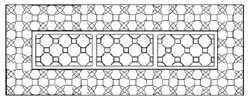|

Texture Map Creation
A number of textures for the Herodian Temple Mount real-time model had to be built from scratch using Photoshop. This was the case for the stucco ceiling panels in the Royal Stoa.
 Earlier excavations in the Jewish Quarter had unearthed a number of painted stucco fragments that Nahman Avigad interpreted as the geometrically patterned ceiling from the reception hall of a palatial mansion. These fragments, and Avigad's reconstruction, served as the basis for the ceiling panels of the Royal Stoa. With the proportions of the panels determined by the geometry of the two-bay section, a line drawing of the possible pattern was built in Photoshop. Following Avigad, the panel featured a central geometric repeat surrounded by a geometric pattern of interlocking circles.
Earlier excavations in the Jewish Quarter had unearthed a number of painted stucco fragments that Nahman Avigad interpreted as the geometrically patterned ceiling from the reception hall of a palatial mansion. These fragments, and Avigad's reconstruction, served as the basis for the ceiling panels of the Royal Stoa. With the proportions of the panels determined by the geometry of the two-bay section, a line drawing of the possible pattern was built in Photoshop. Following Avigad, the panel featured a central geometric repeat surrounded by a geometric pattern of interlocking circles.
 Once approved by the reconstruction team, a ground of cream stucco was constructed and the coloration process began. A photograph of fragments from the excavations in the Jewish Quarter was digitized and used as a guide for the panel colors. Four colors were ultimately sampled from the fragments: deep purple, terra cotta, gold, and mauve. Experiments with various combinations of these colors were conducted before the final pattern was chosen.
Once approved by the reconstruction team, a ground of cream stucco was constructed and the coloration process began. A photograph of fragments from the excavations in the Jewish Quarter was digitized and used as a guide for the panel colors. Four colors were ultimately sampled from the fragments: deep purple, terra cotta, gold, and mauve. Experiments with various combinations of these colors were conducted before the final pattern was chosen.
The final step in creating the texture was to add a deep shadow along the northern edge and light shadows along the east and western edges. (Animation models often calculate accurate shadows based on a defined light source during the rendering process; this is impossible for real-time models because of the speed required to render each frame. To add realism to the Herodian Temple Mount model, shadows were calculated and incorporated into the textures.)

|

